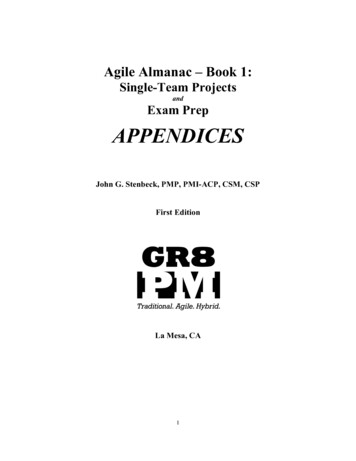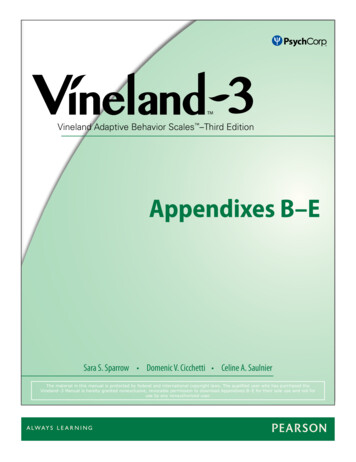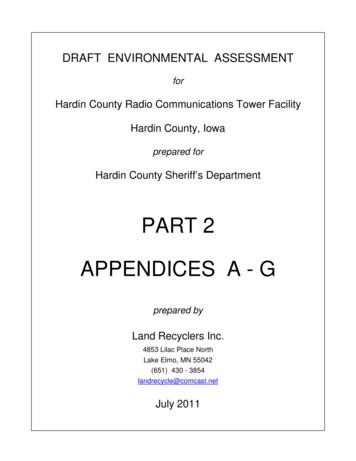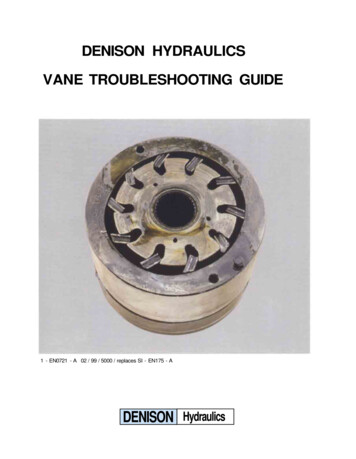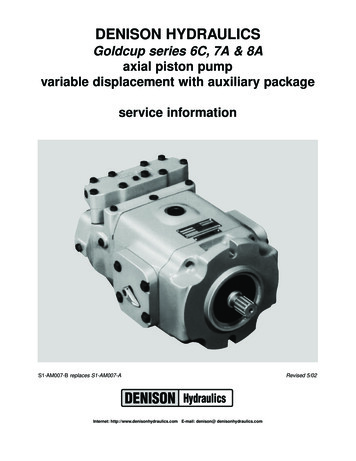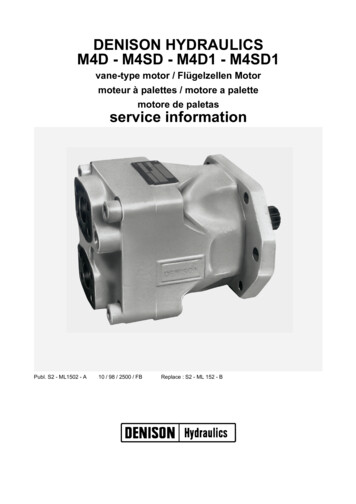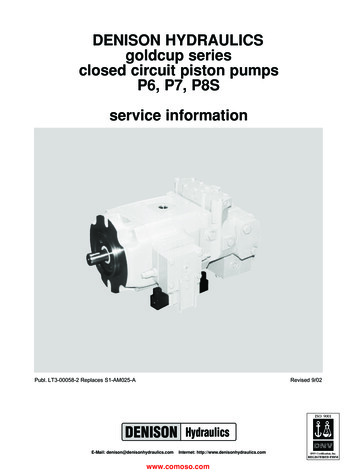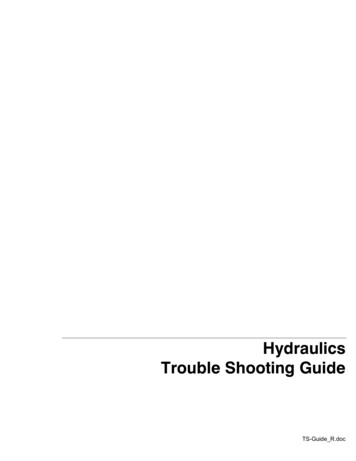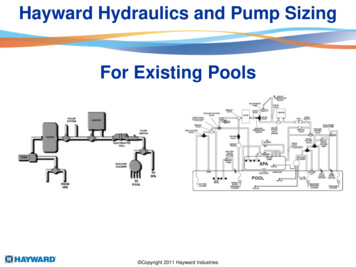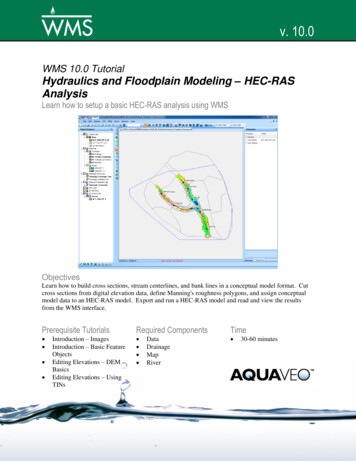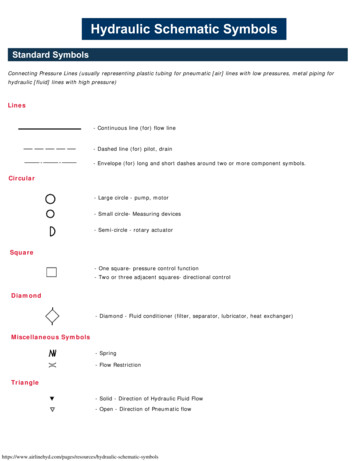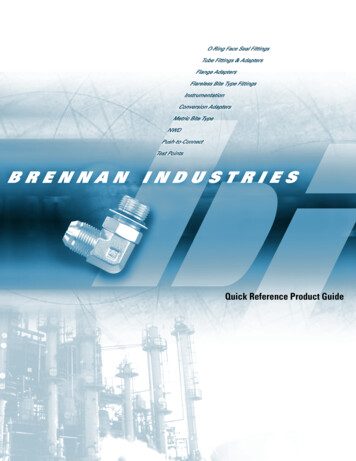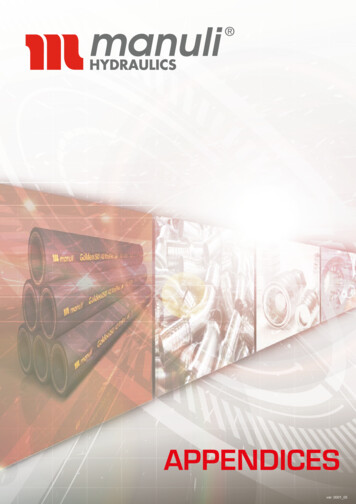
Transcription
APPENDICESver. 0001 05
MACHINESM 1-1ver. 0001 05www.manuli-hydraulics.com
LEGEND OF SYMBOLSInside Diameter (I.D.)APPENDICIES A 1-1Outside Diameter (O.D.)Minimum Bend RadiusReinforcement Outside Diameter (R.O.D.)Maximum Working PressureFerrule / SocketWeightBurst Pressure: The minimum guaranteed burst pressure of the hose; Equivalent orsuperior to the minimum requirements of the reference specifications.InsertMFIPSPXLISBLPLMF2000 Multifit typeMF2000 Interlock Plus typeMF2000 Spiralfit typeMF2000 Xtralock typeMF2000 Interlock Super typeMF2000 Blastlock typeMF2000 Push-Lock typeWorking pressure: The maximum pressure at which correct functioning of the quickcoupling is assured. The working pressure is assured in both connected and disconnectedstates.Flow Rate: The quantity of fluid which passes through a cross section of the quickcoupling in a specified unit of time.Connection Effort: The effort required to lock the male insert into the female.Oil Spillage: The quantity of fluid lost from the coupling during the connection/disconnection ection under pressure: Ability to connect and disconnect with thequick coupling under pressure.ver. 0001 05
GLOSSARY OF TERMSContinuous service: Refers to the working temperature rangeAPPENDICIES A 2-1Max. operating temperature (Intermittent service): Peaks of temperature of short duration and totalcumulative duration lower than 5% of the total service life.Recommended fluids: Fluid types that the hose can convey with excellent / good chemicalcompatibility.Hose service life: Cumulative duration of time in which the hose is under operative conditions.ver. 0001 05www.manuli-hydraulics.com
HOSE SIZE CONVERSION /16/16APPENDICIES A 3-1HOSE SIZEver. 0001 05
FLUID COMPATIBILITY CHARTAPPENDICIES A 4-1WARNING: Compatibility of hose and fittings with conveyed fluid is an essential factor in avoidingchemical reactions that may result in release of fluids or failure of the hose or connection. Thischemical compatibility guide must not be used in conjunction with any other compatibility guidesfrom previous or future catalogue editions, bulletins or publications. Incorrect use of these chartscould result in personal injury or property damage.HOSE SELECTION BY MEDIUM AND HOSE TYPEThis hose compatibility chart is a reference of Manuli Hydraulics hose compatibility with various fluid media.It is intended as a guide to chemical compatibility with inner tube materials and assembly lubricants appliedinternally to the hose. The Fluid Compatibility Chart lists the relative resistance of hose tube and fittingmaterials to more common: hydraulic oils other diversified oils families (for hydrokinetic and lubrication applications) chemicalsin three relative separated charts.The ratings shown do not cover all possible variations of all factors, such as temperature, concentration,degradation or fluid contamination, etc. Testing under actual conditions is the best way to assure chemicalcompatibility for critical applications.PART 1: HYDROSTATIC OILS COMPATIBILITY CHART (ACTUAL HYDRAULIC SYSTEMS ANDAPPLICATIONS)The specific recommendations regarding hydraulic fluids are based upon specific laboratory bench testswith fluids, performed according to ISO 1817 and internal methodology, integrated with field experiences andthe advices of various polymers or fluid suppliers. It must be stressed, however, that this informationis offered only as a guide and is not a guarantee. Final hose selection also depends upon pressure,fluid and ambient temperatures, concentration, duration of exposure and special requirements or variations,which may not be known by Manuli Hydraulics. Legal and other regulations must be followed with particularattention.All the combined factors in working operations may impact on the service life of the hose assembly and mustbe carefully considered before releasing a hose for a specific application: the chemical compatibility with theservice fluid is only one of the factors to be considered.It is always recommended to test the specific fluid brand name with the requested hose, in order to verifychemical compatibility. Manuli Hydraulics constantly performs compatibility tests as service to market,progressively updating the compatibility chart.WARNING: Compatibility of hose and fittings with conveyed fluid is an essential factor in avoiding chemicalreactions that may result in release of fluids or failure of the hose or connection. This chemical compatibilityguide must not be used in conjunction with any other compatibility guides from previous or future catalogueeditions, bulletins or publications. Incorrect use of these charts could result in death, personal injury orproperty damage.ver. 0001 05www.manuli-hydraulics.com
FLUID COMPATIBILITY CHARTPART 2: HYDROKINETIC APPLICATIONS AND LUBRICANT OILS COMPATIBILITY CHART(AUTOMATED TRANSMISSIONS AND VARIOUS LUBRICATION SYSTEMS)It is to be underlined that Manuli hoses are designed in principle for use with hydraulic oils only, and thatdiversified applications such as the ones with these categories of other oils, must be verified case by casewith lab and/or field tests by users under their sole and exclusive responsibility and no liability whatsoevercan be attributed to Manuli Hydraulics in that regard.APPENDICIES A 4-2This second part of the compatibility chart list a particular family of oils, not designed for standardhydraulics (hydrostatic applications), rather studied for many diversified applications such as lubricationfor gear, compressors, turbines, diatermic oils for cooling or heat transmission, and ATF (AutomaticTransmission Fluids) oils for the hydrokinetic (hydrodynamic) applications. These fluids are often veryaggressive on traditional tube rubbers, more than hydraulic oils, due to the nature of the fluids andadditives, aimed to give properties of long life duration and high temperature resistance; that’s why theirchemical compatibility with tube rubbers must be carefully checked before eventual use.For more detailed information contact Manuli Hydraulics or visit www.manuli-hydraulics.comPART 3: BEHAVIOUR TO CHEMICALS (GUIDELINES FROM LITERATURE) FOR NONHYDRAULIC APPLICATIONSWARNING: Manuli hoses are designed for hydraulics use and applications, they are not intendedfor industrial diversified applications with various chemicals.The recommendations regarding generic chemicals are mainly based on literature data in conjunction withpolymers used for the tube compound. The field results of the fluid conveyed in the hose should be carefullytested and field validated by users.No test on finished hose assemblies in combination with the mentioned chemicals has been normallyperformed.The possible good rating and on field performance of the hose with a chemical mentioned in the listdoes not mean in any case the release by Manuli Hydraulics of the product for that application orany guarantee. The possible validation for use is under the sole and exclusive responsibility of theend user and no liability whatsoever can be attributed to Manuli Hydraulics in that regard. In factManuli Hydraulics hoses are designed for hydraulics use and applications, they are not intendedfor industrial diversified applications with various chemicals.The outer cover of the hose is intended to protect the reinforcement layer(s) from mechanical influences(abrasion, weathering etc.); cover compounds are not designed to exhibit the same chemical resistance asthe tube compounds. Manuli Hydraulics should be consulted about the compatibility of the cover, shouldthe application involve the extended exposure or immersion in a liquid: anyway the hydraulic hoses ofthe Manuli Hydraulics product range are not designed in general for immersion in the service fluid.WARNING: Compatibility of hose and fittings with conveyed fluid is an essential factor in avoiding chemicalreactions that may result in release of fluids or failure of the hose or connection. This chemical compatibilityguide must not be used in conjunction with any other compatibility guides from previous or future catalogueeditions, bulletins or publications. Incorrect use of these charts could result in death, personal injury orproperty damage.ver. 0001 05
FLUID COMPATIBILITY CHARTAPPENDICIES A 4-3This type of special applications should be avoided or carefully studied with additional external protectionsfor the hoses, selection of special hose types, e.g. with thermoplastic cover and validation on the specificapplication. The turbulence of the fluid, the high temperature and nature of the fluid as well as otherelements may impact the properties or integrity of the hose cover material (the cover compound of the hoseis designed to resist to oil drops and external agents, not immersion in the service fluid).For more detailed information contact Manuli Hydraulics or visit www.manuli-hydraulics.comWARNING: No tests on finished hose assemblies in combination with the mentioned chemicals has been normallyperformed. The possible good rating and on field performance of the hose with a chemical mentioned in the list,does not mean in any case the release by Manuli Hydraulics of the product for that application or any guarantee. Thepossible validation for use is under the sole and exclusive responsibility of the end user and no liability whatsoever canbe attributed to Manuli Hydraulics in that regard. In fact Manuli Hydraulics hoses are designed for hydraulics use andapplications, they are not intended for industrial diversified applications with various chemicals. No tests on finishedhose assemblies in combination with the mentioned chemicals has been normally performed.LEGEND OF HOSE TYPES BY TUBE COMPOUNDSTube compound categoriesHose TypesNITRILEstd wire braid, textile braid & wire spiral hoses (Tractor, Harvester, Lyteflex, Firend, Goldenspir, Astro, Multitex,Pushfit, Cover, Spirtex/K, Rockmaster, Shieldmaster, Twinpower, GoldenISO, Goldenguard, Diamondspir,Xtraflow/4WS & 2WB, Pilot, Jackmaster)CHLOROPRENEEternity/2, Nozone/2K, GoldenblastCHLOROSULPHONATEDPOLYETHYLENEEquator/1 (Blue & Black), Equator/2 (Blue & Black), Xtraflow/HTCHLORINATED POLYETHELENEMastertexPOLYESTERHydroplast, HydrotwinWARNING: Compatibility of hose and fittings with conveyed fluid is an essential factor in avoiding chemicalreactions that may result in release of fluids or failure of the hose or connection. This chemical compatibilityguide must not be used in conjunction with any other compatibility guides from previous or future catalogueeditions, bulletins or publications. Incorrect use of these charts could result in death, personal injury orproperty damage.ver. 0001 05www.manuli-hydraulics.com
FLUID COMPATIBILITY CHARTHOW TO USE THE CHARTHydraulic fluids are listed in alphabetic order with the manufacturer brand name and ISO identificationsymbol (DIN when available), chemicals are listed alphabetically; Find the hose type and read the compatibility rating (see rating scale); Define the proper hose selection for the application by choosing the best rating.LEGEND OF RATINGSE Excellent - Small or negligible changes of compound properties: no problem for use. Service life canexceed the expectations.APPENDICIES A 4-4 G Good - There are only minor changes of some compound properties. Service life is normally in line withstate of the art (standard) expectations.C Conditional - Significant changes on some compound properties. Service life can be reduced; higherdurability can be achieved with reduced severity of working conditions (temperature in particular) or withan upgraded hose selection. Whenever possible, a field validation under actual working conditions isrecommended.X Not recommended - Unsuitable, severe effects on physical properties.REMARKS O-Rings used with couplings must also be considered for chemical compatibility with the fluid to beconveyed. This includes fittings containing internal O-Rings; for example Metric Female 24 Cone seatfittings, etc. Standard O-Ring of Manuli Hydraulics fittings are made of Nitrile rubber (NBR), highly chemicallycompatible with all hydraulic fluids. If you use special fluids or very high temperatures, different O-Ringmaterials should be used, contact Manuli Hydraulics for specific information. See Technical Manual fordimensions of O-Rings. Compatibility of hose fittings with conveyed fluids is an essential factor in avoiding chemical reactionsthat may result in release of fluids and failure of the connection with the potential of causing severepersonal injury or property damage. Standard Manuli Hydraulics fittings are made of carbon steel withHexavalent chromium free plating.WARNING: Compatibility of hose and fittings with conveyed fluid is an essential factor in avoiding chemicalreactions that may result in release of fluids or failure of the hose or connection. This chemical compatibilityguide must not be used in conjunction with any other compatibility guides from previous or future catalogueeditions, bulletins or publications. Incorrect use of these charts could result in death, personal injury orproperty damage.ver. 0001 05
FLUID COMPATIBILITY CHARTOILS CLASSIFICATION - ACCORDING TO ISO 6743-4APPENDICIES A 4-5ISO 6743-4 is an important norm regarding “Lubricants, industrial oils and related products (class L)”. Thenorm defines a very wide family of oils, used in many different sectors and applications.The oils must be carefully understood and properly managed to avoid problems and possible mistakes. ThePart 4 of the norm in particular regards the Hydraulic Oils (Family H), for hydrostatic and hydrokinematicapplications, the other parts of the norm regard other fluids, of different nature or aimed to differentapplications than hydraulics.Manuli Hy
www.manuli-hydraulics.com APPEDICIES A 2-1 1-1 LEGEND OF SYMBOLS Inside Diameter (I.D.) Outside Diameter (O.D.) Minimum Bend Radius Reinforcement Outside Diameter (R.O.D.) Maximum Working Pressure Ferrule / Socket Weight Burst Pressure: The minimum guaranteed burst pressure of the hose; Equivalent or superior to the minimum requirements of the reference specifications. Insert
